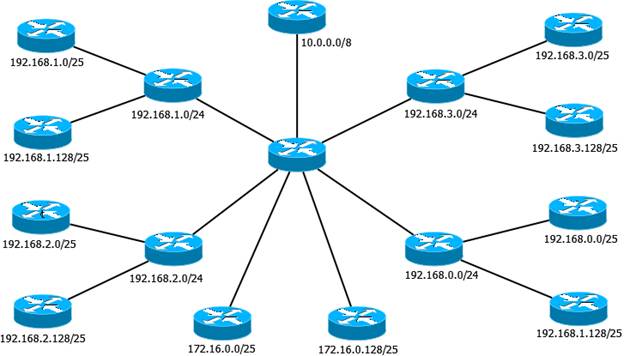
However, route summarization to the default classful mask is not possible in today’s networks and we must use CIDR to summarize our routes. If the Internet today would use classful routing protocols and classful route summarization, we would be out of IP address for quite some time now.
I would like you to imagine now how it would be for your router if it will receive the full prefix list table with all the IP addresses used in the Internet today. Some companies have large blocks assigned, such as a /8 prefix, while others have smaller blocks, even /30. If there would be no route summarization done, you would end up a lot of prefixes in your prefix table and your router would forward traffic much slower because he will search the destination address in a much bigger list of prefixes.
When you use route summarization, your router is trying to find which networks can be aggregated as a single, bigger network, without breaking the routing that must be done to reach that network.
We will take for example 7 prefixes, as outlined in the above network diagram, and explain to you what’s happening to them when the router tries to summarize them: 192.168.0.0/24, 192.168.1.0/24, 192.168.2.0/24, 192.168.3.0/24, 172.16.0.0/25, 172.16.0.128/25 and 10.0.0.0/8.
When the top level router inspects its route table, he sees that the 192.168.x.0/24 networks can be combined within a bigger network, a /21 prefix. He summarizes this network as 192.168.0.0/21. Because the resulting prefix is bigger than the class C default, from which our network is part of, this process is called supernetting.
Next, he sees that he can summarize the 172.16.0.0/25 and 172.16.0.128/25 to 172.16.0.0/24 also. Please note that the default CIDR prefix for this class B network is /16, and what we have here is a /24. This process is not supernetting, like in the previous example, it’s simple subnetting.
The router also sees there’s a 10.0.0.0/8 network, but he doesn’t have any networks to which it can summarize, so it leaves this network as-is. Routers holding the subnets, for example the router holding 192.168.0.0/24, also summarize their routes. They do not advertise the networks as 192.168.0.0/25 and 192.168.0.128/25 to the top level router, instead they summarize these two networks as 192.168.0.0/24. The top level router must only know that the network 192.168.0.0/24 is available through that router, and he must not have knowledge about the subnets of that network.
Because the networks 172.16.0.0/25 and 172.16.0.128/25 are not handled by the same router, the top level router will treat them as two separate prefixes and he will have knowledge of both networks, not the summarized one. If the top level router is connected to another one, for example, the router of your service provider, he will advertise to that router the summarized network. The router at your service provider must know only the summarized route because our top level router will know how to handle packets for those networks.
The routers handling the other networks of our network, for example the router handling the 10.0.0.0/8 network, also have to know only the summarized routes, for example, he must only know that he can reach the 192.168.0.0/21 and the 172.16.0.0/24 networks through our top level router. When our top level router will receive a packet with the destination address of one of its networks, he will know how to route it to reach the desired network.
If you are using a routing protocol, after the router examined its routing table and made the necessarily route summarizations, he advertises the summarized routes to its neighbors.
If you want to calculate what the summarized routes will be, first of all you must convert the network addresses to their binary forms, next you have to count the number of left-most matching bits to determine the mask for the summary route and then you have to copy those bits and add zeros to determine the summarized network address. For example, let’s see how the router summarizes the networks 172.20.0.0/16, 172.21.0.0/16, 172.22.0.0/16 and 172.23.0.0/16.
172.20.0.0 – 10101100 . 00010100 . 00000000 . 00000000
172.21.0.0 – 10101100 . 00010101 . 00000000 . 00000000
172.22.0.0 – 10101100 . 00010110 . 00000000 . 00000000
172.23.0.0 – 10101100 . 00010111 . 00000000 . 00000000
We see that the first 14 bits are matching, therefore the prefix for this network will be /14 (subnet mask 255.252.0.0).
Next, we copy the first 14 matching bits, and we add zero bits to determine the network address.
10101100 . 00010100 . 00000000 . 00000000
If we do the math, we’ll find out that the network address is 172.20.0.0, therefore our summarized route will be 172.20.0.0/14.
We hope you find this CCNA article covering Route summarization helpful in your preparation for taking the CCNA exam. Understanding IP, VLSM, CIDR and how routers use them is very important for passing the CCNA exam, as well as for your day-to-day networking activities.
